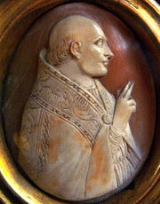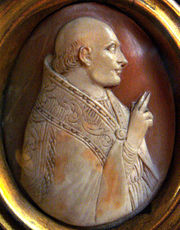
Jean Lemoine
Encyclopedia
Jean Lemoine, Johannes Monachus (born 1250 at Crécy-en-Ponthieu
, died 8/22/1313 at Avignon
) was a French canon lawyer, Cardinal
, bishop of Arras and papal legate
. He served Boniface VIII as representative to Philip IV of France
, and founded the Collège du cardinal Lemoine, in Paris
.
. He then became a canon of the cathedral chapters at Amiens
and then in Paris. A royal adviser, he travelled to Rome
, and was made Auditor of the Rota in 1282.
at the end of 1293. At the same period he was papal Vice-Chancellor, signing the papal bull
s (1288 to 1294). Pope Celestine V
created him cardinal, with the title of Saints Marcellin and Peter, at the consistory
of 18 September 1294.
He subsequently had built, in the nave
of Notre-Dame de Paris, the chapel called the "altar of the lazy".
The pope modified the interdict to an excommunication
of the king. Phillipe intercepted the messengers with the bull, at Troyes
, and placed the legate Jean under surveillance. The king then called together the États Généraux (1303). The Cardinal left Paris by night, and returned to Rome.

in Perugia
that elected Clement V; but he attended the new pope in France. He became cardinal-protopriest
at the death of Cardinal Robert Pontigny in October 1305. On 6 November 1305, he was elected Camerlengo of the Sacred College of Cardinals
. He stayed with Clement through all his wanderings, through to Avignon where the pope stationed himself in 1309.
Cardinal Lemoine died in Avignon. His will, dated 21 July 1313, asks that he should be buried in the chapel of his College in Paris, in rue Saint-Victor. These wishes were carried out on 1 October 1314.
His brother André Lemoine, bishop of Noyon, was a benefactor of the College; he died in 1315. The brothers were buried in the same tomb, and a joint epitaph could be seen there up to the end of the eighteenth century.
He formulated presumption of innocence
in words item quilbet presumitur innocens nisi probetur nocens (a person is presumed innocent until proven guilty)
Crécy-en-Ponthieu
Crécy-en-Ponthieu is a commune in the Somme department in Picardie in northern France, located south of Calais. It gives its name to Crécy Forest, which starts about two kilometres to the south-west of the town and which is one of the largest forests in the north of France...
, died 8/22/1313 at Avignon
Avignon
Avignon is a French commune in southeastern France in the départment of the Vaucluse bordered by the left bank of the Rhône river. Of the 94,787 inhabitants of the city on 1 January 2010, 12 000 live in the ancient town centre surrounded by its medieval ramparts.Often referred to as the...
) was a French canon lawyer, Cardinal
Cardinal (Catholicism)
A cardinal is a senior ecclesiastical official, usually an ordained bishop, and ecclesiastical prince of the Catholic Church. They are collectively known as the College of Cardinals, which as a body elects a new pope. The duties of the cardinals include attending the meetings of the College and...
, bishop of Arras and papal legate
Papal legate
A papal legate – from the Latin, authentic Roman title Legatus – is a personal representative of the pope to foreign nations, or to some part of the Catholic Church. He is empowered on matters of Catholic Faith and for the settlement of ecclesiastical matters....
. He served Boniface VIII as representative to Philip IV of France
Philip IV of France
Philip the Fair was, as Philip IV, King of France from 1285 until his death. He was the husband of Joan I of Navarre, by virtue of which he was, as Philip I, King of Navarre and Count of Champagne from 1284 to 1305.-Youth:A member of the House of Capet, Philip was born at the Palace of...
, and founded the Collège du cardinal Lemoine, in Paris
Paris
Paris is the capital and largest city in France, situated on the river Seine, in northern France, at the heart of the Île-de-France region...
.
Early life
He was awarded degrees in canon law and theology by the University of ParisUniversity of Paris
The University of Paris was a university located in Paris, France and one of the earliest to be established in Europe. It was founded in the mid 12th century, and officially recognized as a university probably between 1160 and 1250...
. He then became a canon of the cathedral chapters at Amiens
Amiens
Amiens is a city and commune in northern France, north of Paris and south-west of Lille. It is the capital of the Somme department in Picardy...
and then in Paris. A royal adviser, he travelled to Rome
Rome
Rome is the capital of Italy and the country's largest and most populated city and comune, with over 2.7 million residents in . The city is located in the central-western portion of the Italian Peninsula, on the Tiber River within the Lazio region of Italy.Rome's history spans two and a half...
, and was made Auditor of the Rota in 1282.
Between France and Rome
He was dean of Bayeux Cathedral, from 1288 to 1292. He was then elected as bishop of ArrasArras
Arras is the capital of the Pas-de-Calais department in northern France. The historic centre of the Artois region, its local speech is characterized as a Picard dialect...
at the end of 1293. At the same period he was papal Vice-Chancellor, signing the papal bull
Papal bull
A Papal bull is a particular type of letters patent or charter issued by a Pope of the Catholic Church. It is named after the bulla that was appended to the end in order to authenticate it....
s (1288 to 1294). Pope Celestine V
Pope Celestine V
Pope Saint Celestine V, born Pietro Angelerio , also known as Pietro da Morrone was elected pope in the year 1294, by the papal election of 1292–1294, the last non-conclave in the history of the Roman Catholic Church...
created him cardinal, with the title of Saints Marcellin and Peter, at the consistory
Consistory
-Antiquity:Originally, the Latin word consistorium meant simply 'sitting together', just as the Greek synedrion ....
of 18 September 1294.
Foundations in Paris
As patron, he contracted at Rome (15 March 1302), to buy from the Grands-Augustins the Maison du Chardonnet and adjoining land to found a college. Initially, la Maison du Cardinal, after his death it was called Collège du cardinal Lemoine. Initially it was to take 60 theology students and 40 in the arts. It received approval from Boniface VIII on 12 May 1302.He subsequently had built, in the nave
Nave
In Romanesque and Gothic Christian abbey, cathedral basilica and church architecture, the nave is the central approach to the high altar, the main body of the church. "Nave" was probably suggested by the keel shape of its vaulting...
of Notre-Dame de Paris, the chapel called the "altar of the lazy".
Legate
On 24 November 1302, Boniface VIII sent him to France as legate to Philippe le Bel. Philippe stood up to papal demands, and the Cardinal laid an interdict on the kingdom, requiring Nicolas de Fréauville, the king's confessor, to attend Rome with an explanation.The pope modified the interdict to an excommunication
Excommunication
Excommunication is a religious censure used to deprive, suspend or limit membership in a religious community. The word means putting [someone] out of communion. In some religions, excommunication includes spiritual condemnation of the member or group...
of the king. Phillipe intercepted the messengers with the bull, at Troyes
Troyes
Troyes is a commune and the capital of the Aube department in north-central France. It is located on the Seine river about southeast of Paris. Many half-timbered houses survive in the old town...
, and placed the legate Jean under surveillance. The king then called together the États Généraux (1303). The Cardinal left Paris by night, and returned to Rome.

Camerlengo in Avignon
Because of illness, he was absent from the papal conclavePapal conclave
A papal conclave is a meeting of the College of Cardinals convened to elect a Bishop of Rome, who then becomes the Pope during a period of vacancy in the papal office. The Pope is considered by Roman Catholics to be the apostolic successor of Saint Peter and earthly head of the Roman Catholic Church...
in Perugia
Perugia
Perugia is the capital city of the region of Umbria in central Italy, near the River Tiber, and the capital of the province of Perugia. The city is located about north of Rome. It covers a high hilltop and part of the valleys around the area....
that elected Clement V; but he attended the new pope in France. He became cardinal-protopriest
Protopriest
Protopriest — in the College of Cardinals, is the first Cardinal-Priest in the order of precedence. This title is always attached to the most senior Cardinal Priest according to date of his creation. From the 17th century until the end of 19th century Protopriest usually opted for the titulus San...
at the death of Cardinal Robert Pontigny in October 1305. On 6 November 1305, he was elected Camerlengo of the Sacred College of Cardinals
Camerlengo of the Sacred College of Cardinals
The Camerlengo of the Sacred College of Cardinals was the treasurer of that body.He administered all property, fees, funds and revenue belonging to the College of Cardinals, celebrated the requiem Mass for a deceased cardinal and was charged with the registry of the Acta Consistoralia.It is...
. He stayed with Clement through all his wanderings, through to Avignon where the pope stationed himself in 1309.
Cardinal Lemoine died in Avignon. His will, dated 21 July 1313, asks that he should be buried in the chapel of his College in Paris, in rue Saint-Victor. These wishes were carried out on 1 October 1314.
His brother André Lemoine, bishop of Noyon, was a benefactor of the College; he died in 1315. The brothers were buried in the same tomb, and a joint epitaph could be seen there up to the end of the eighteenth century.
Works
His Glossa aurea Joannis Monachi cardinalis in Sextum Decretalium, a commentary on the sixth book of the Decretals, was printed in Paris in 1515.He formulated presumption of innocence
Presumption of innocence
The presumption of innocence, sometimes referred to by the Latin expression Ei incumbit probatio qui dicit, non qui negat, is the principle that one is considered innocent until proven guilty. Application of this principle is a legal right of the accused in a criminal trial, recognised in many...
in words item quilbet presumitur innocens nisi probetur nocens (a person is presumed innocent until proven guilty)
Placenames
- The rue du Cardinal-Lemoine is a street in the 5e arrondissement, Paris
- The station Cardinal Lemoine is on line 10 of the Paris métroParis MétroThe Paris Métro or Métropolitain is the rapid transit metro system in Paris, France. It has become a symbol of the city, noted for its density within the city limits and its uniform architecture influenced by Art Nouveau. The network's sixteen lines are mostly underground and run to 214 km ...
.

